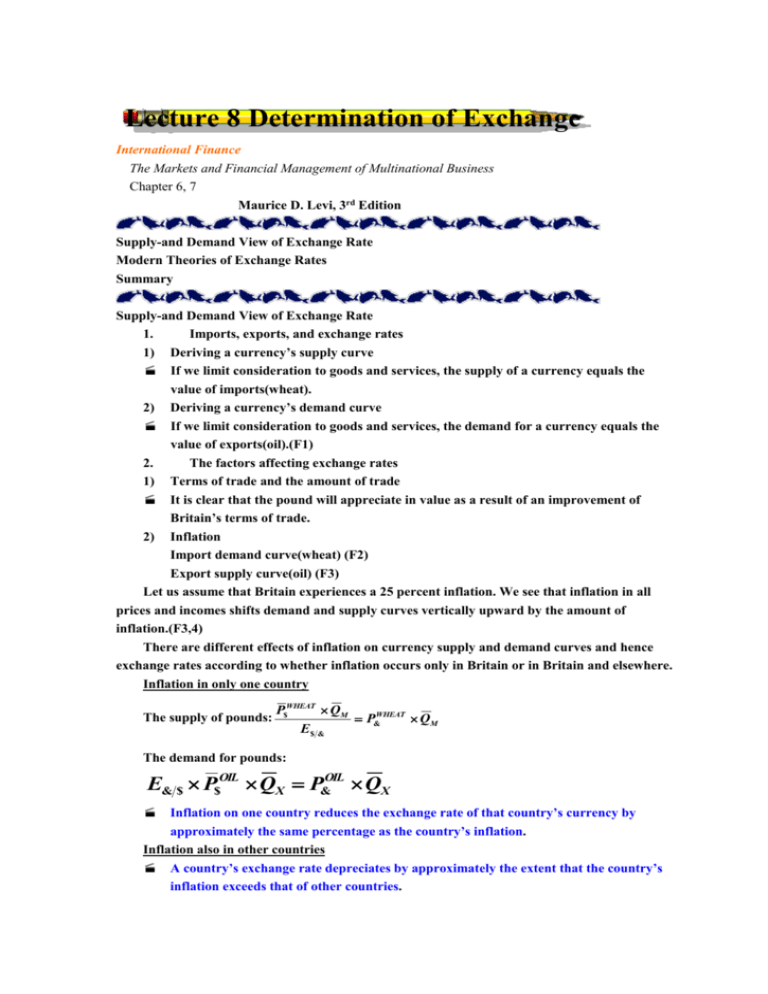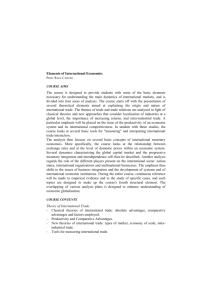International Finance The Markets and Financial Management of
advertisement

Lecture 8 Determination of Exchange International Finance Rates The Markets and Financial Management of Multinational Business Chapter 6, 7 Maurice D. Levi, 3rd Edition Supply-and Demand View of Exchange Rate Modern Theories of Exchange Rates Summary Supply-and Demand View of Exchange Rate 1. Imports, exports, and exchange rates 1) Deriving a currency’s supply curve If we limit consideration to goods and services, the supply of a currency equals the value of imports(wheat). 2) Deriving a currency’s demand curve If we limit consideration to goods and services, the demand for a currency equals the value of exports(oil).(F1) 2. The factors affecting exchange rates 1) Terms of trade and the amount of trade It is clear that the pound will appreciate in value as a result of an improvement of Britain’s terms of trade. 2) Inflation Import demand curve(wheat) (F2) Export supply curve(oil) (F3) Let us assume that Britain experiences a 25 percent inflation. We see that inflation in all prices and incomes shifts demand and supply curves vertically upward by the amount of inflation.(F3,4) There are different effects of inflation on currency supply and demand curves and hence exchange rates according to whether inflation occurs only in Britain or in Britain and elsewhere. Inflation in only one country The supply of pounds: P$WHEAT QM P&WHEAT QM E$ & The demand for pounds: E& $ P$OIL QX P&OIL QX Inflation on one country reduces the exchange rate of that country’s currency by approximately the same percentage as the country’s inflation. Inflation also in other countries A country’s exchange rate depreciates by approximately the extent that the country’s inflation exceeds that of other countries. 3) 4) 3. 1) Service trade, income flows, and transfers Foreign investment(F6) The stability of exchange rates The conditions required for instability Currency supply and import elasticity(F7) Stability of foreign exchange markets(F8,9,10) Marshall-Lerner condition Will a depreciation of the home currency lead to a decrease in the excess demand for foreign exchange? The problem is to assess the change in the current account balance that results when there is a change in the exchange rate. the link between the demand curve for imported goods and services and the supply curve of foreign exchange(F11,12) Exchange market stability and the Marshall-Lerner condition(F11): In the case of unbalanced trade(expressed in units of home currency) X Dx Dm 1 M 2) Unstable exchange rates and the balance of trade The foreign exchange market is unstable only if the value of exports does not increase sufficiently to compensate for inelastic import demand. 4. Short-run versus long-run trade elasticities and the J curve 1) Complete exchange rate pass-through It is assumed that a change in the exchange rate registered fully as a change in goods prices facing consumers in the buying country. Appleyard and Field(2001): PP 535-544 2) Adjustment time and the foreign exchange market(F13) 3) Exchange rate pass-though of foreign exports to the United States Jiawen Yang(1997) Elasticity of exchange rate pass-through on an industry basis is the percentage change in the import price index for a good(in dollars) divided by the percentage change in the (nominal effective) exchange rate. Yang’s estimates were that, in 77 of the 87 industries, the elasticities of pass-through were positive but less than 1.0. He postulated that the elasticity of pass-through would be higher with greater product differentiation in an industry. Yang expected that pass-through would be smaller the greater the elasticity of marginal cost of production with respect to output in the supplying firms in the industry. Yang specified that the degree of pass-through could be affected by the market share of foreign firms----his hypothesis was that the degree of pass-though would be inversely relayed to a foreign firm’s market share 4) Japanese export pricing and pass-through in the 1990s Thomas Klitgaard(1999) During the 1990s, the yen strongly appreciated relative to the dollar from 1991 to 1995 and strongly depreciated from 1995 to 1998. In general, Klitgaard concluded that a 10 percent change in the price of the yen would lead to roughly a 4 percent offsetting change in the profit margin (relative to the profit margin on goods sold in Japan). 5) J-curve Modern Theories of Exchange Rates 1. Stock versus flow theories of exchange rates The supply-and demand view of exchange rtes considers flows of currencies. An alternative way of viewing exchange-rate determination is in terms of the stocks of currencies relative to the willingness of people to hold these stocks. Several variants of stock-based theories of exchange rtes have been developed in recent years. Monetary approach Asset approach Portfolio-balance approach 2. The monetary theory of exchange rates 1) The monetary theory of exchange rates is the flexible-exchange-rate form of the monetary approach to the balance of payments which pertains to fixed exchange rates. 2) There are two essential components to the monetary theory of exchange rates. The first relates the price levels in different countries to the countries’ money supplies, and the second relates price levels to exchange rates. A specific version of the demand equation for money(John Bilson): M US QUS e US PUS M UK QUK e UK PUK If the money demand equals the money supply, US PUS MUS QUS e UK PUK MUK QUK e PPP principle, S$ & S$ & PUS PUK M US M UK QUK QUS The money supply Real GNP Interest rate Expected inflation ( US UK ) e 3) A brief look at empirical work on the monetary approach the monetary approach under fixed exchange rates Junichi Ujiie(1978): 1959-1972 BOP = a + bΔD + cΔi* + fΔY BOP=an official reserve transactions surplus ΔD=the change in domestic credit, b<0test is robust Δi*=the change in foreign interest rates, c>0? (monetary approach) ΔY=the change in Japanese real income, f>0? the monetary approach under flexible exchange rates Jacob Frenkel(1978): February 1921-August 1923(the German hyperinflation period) log e a b log M s c log E ( p ) e=units of German marks per one U.S. dollar; 1=b>0,c>0 The Frenkel test gives substantial support for the monetary approach to the exchange rate. Rudiger Dornbusch(1980): 1973-1979 e a b(ms ms *) c( y y*) d (i i*) S f (i i*) L home country =Canada, France, Japan, the UK, the US foreign country =West Germany,* Dornbusch concluded that, at least from his testing, there is “little doubt that the monetary approach … is an unsatisfactory theory of exchange rate determination” MacDonald and Taylor(1992): the summary statement that the “monetary approach appears reasonably well supported for the period up to 1978” but that this is not true for studies using sample years after that time. Mark Taylor(1995): the later estimating equations for exchange rates often contained incorrect signs. 3. The asset approach to exchange rates The asset approach to exchange rates looks at the current spot exchange rate as a reflection of the market’s best evaluation of what is likely to happen to the exchange rate in the future. The random component fluctuates around the expected change in the exchange rate. The effect of fiscal policy as well as monetary policy: 4. The portfolio-balance approach to exchange rates 1) People might want to hold both monies and bonds. It recognizes that supplies and demands for monies and bonds must balance. We find effects of bond supplies and demands on exchange rates and interest rates. 2) The portfolio-balance theory(F14) The line MM represents all of the interest rate/exchange rate combinations consistent with equilibrium in the U.S. money market. E $ /& rUS M D , M S ValueBritishbonds Wealth M D currency The line BB represents all of the interest rate/exchange rate combinations consistent with equilibrium in the U.S. bond market. rUS Demand U . S . Bond , Supply E$ /& ValueBritishbonds Wealth Demand U . S . Bond currency 5. 1) 2) 3) 4) Effect of open-market operations The portfolio-balance theory recognizes that in addition to the direct effect of the money supply, there is also an effect of the excess demand for bonds caused by the central bank’s purchase of bonds; the supply of bonds available to the public is reduced. Unlike the monetary approach, the portfolio-balance approach predicts that the effect of changes in money supplies on exchange rates depends on how money supplies are changed. The effect of a higher U.S. real GNP(F14) We see that the exchange-rate appreciation is the result of adjustments in both the money and bond markets and therefore is larger than the exchange-rate appreciation occurring only via the money market. Theories of exchange-rate volatility The Dornbusch sticky-price theory Exchange-rate overshooting “overshooting” occurs when exchange rates go beyond their new equilibrium before returning to it. Dornbusch(1976)(F15) Varying elasticities Stock adjustment and flow fluctuations Other theories of overshooting Summary Several theories of exchange rates have been advanced which are based on the stocks of countries’ monies versus the demands to hold these monies. The sock-based theories differ according to the assets they consider and whether they involve expectations of the future The monetary approach to exchange rates is based on links between money supplies and price levels and between price levels and exchange rates. The monetary approach predicts that an exchange rate will depreciate by the excess of money growth in one country over another. It also predicts that faster growth of real GNP will cause appreciation and that higher interest rates and expected inflation will cause depreciation. The asset approach to exchange rates suggests that the current exchange rate depends on the expected future exchange rate. Since the expected future rate can depend on expected inflation or anything appearing in the balance-of-payments account, the asset approach is consistent with other theories of exchange rates. The portfolio-balance approach assumes different countries’ bonds are not perfect substitutes. As a result, changes in preferences for bonds of one country over another, or changes in bond supplies, can affect exchange rates. If prices are sticky, exchange rates may overshoot their equilibrium. Other explanations of exchange-rat overshooting include varying elasticities of import demand and export supply, and jumps in currency supplies or demands caused by portfolio readjustment.








